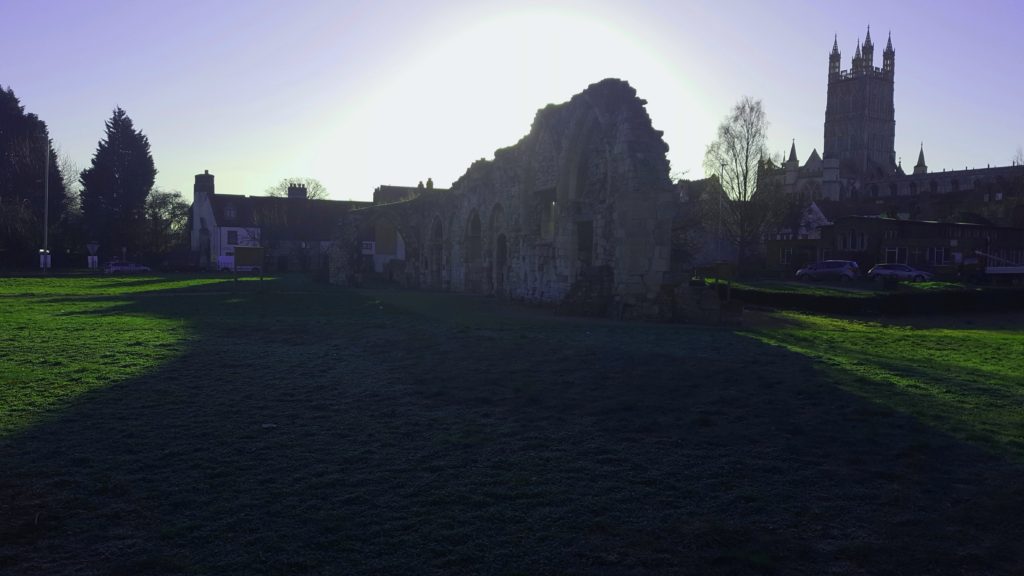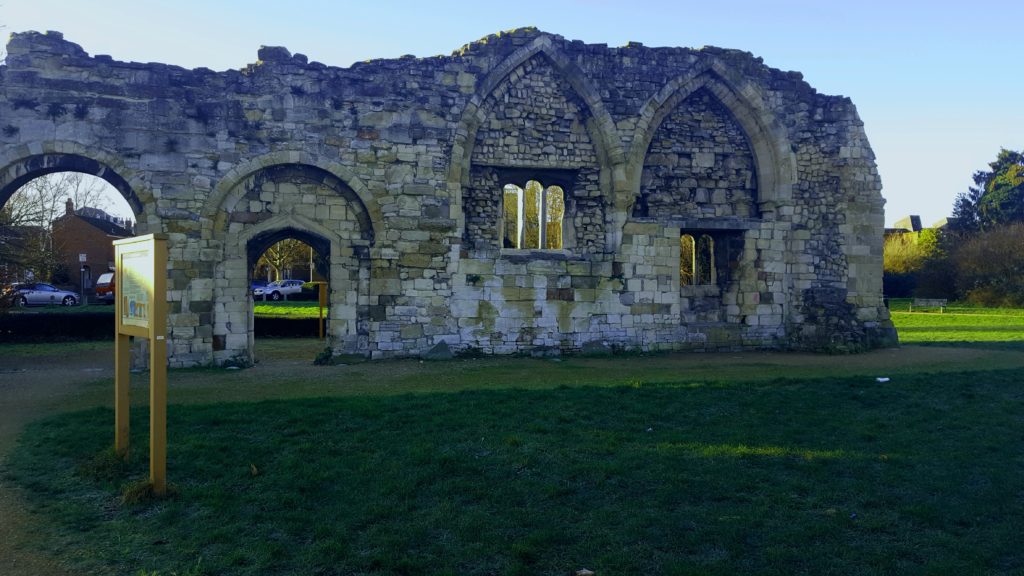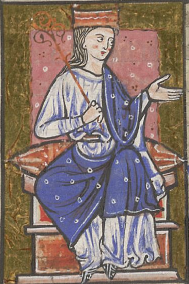I took a walk on the outskirts of Gloucester today – mostly so I could grab a couple of photos for one of the sections of my Newsletter. During my walk, I visited St Oswald’s Priory, which has some interesting history attached to it – as, indeed, does all of Gloucester – especially with reference to local heroine and fierce Saxon Queen, Æthelflæd. So much so, that when I began to incorporate a bit of background in my newsletter, I realised I had a blog post and was in danger of giving my subscribers a history lesson they never asked for. So in the end, I turned it into a blog post and gave my readers the option of whether they wanted to read it or not!

The now ruined Priory was built over 1000 years ago from stone gleaned from Roman ruins. Of course, Gloucester, or Glevum as it would have been called in Roman times, was originally settled by the pre-Celtic inhabitants of Briton. When the Romans arrived and took over the major trading hub, an Iron Age tribe was already in residence – probably the Dobunni. Gloucester and Dorchester (where I was born) and many other towns ending in ‘cester’ have much in common, in terms of history and ruins left by Roman occupation. As the Roman Empire collapsed, local Celtic tribes moved in and reclaimed the territory. They disdained the Roman architecture and way of life, so much of the town fell into disuse and ruin. Until the Saxons invaded, capturing the territory from the locals in 577 A.C.E. The Saxons were perfectly happy to use Roman built structures and the town was revived.
Without getting lost in the woods here, the Danes invaded Britain – which at the time was a Heptarchy of seven smaller kingdoms (Not including large tracts of Scotland, Wales or Cornwall. Cornwall was, in fact, known as ‘West Wales’ by the early Saxons, and High Welsh was spoken in Wales, Cornwall and lower Scotland at the time, suggesting a common origin for those tribes.) Those early Saxons built an Abbey Dedicated to St Peter which later became Gloucester Cathedral. Gloucester was then part of Mercia – the middle Saxon kingdom.

Æthelflæd, daughter of Alfred the Great (King of Wessex and, as most historian agree, first king of a united England ) had the priory built sometime between 880 A.C.E. and 890 A.C.E. For some reason, she (and her husband?) chose a site that was literally in the shadow of the Abbey. If you look at the first picture, you can see the tower of Gloucester Cathedral in the background. Originally, the Priory was also dedicated to St Peter, however, when the bones of St Oswald were recovered from Northumbria, Æthelflæd had them brought to the Priory and buried there. The Priory was renamed in the saint’s honour and, despite the presence of the larger Abbey, became a wealthy concern due to donations and offerings given by pilgrims who visited the shrine. Various miracles, typical of those recorded at the time, were documented. What interests me is what a huge presence Æthelflæd was and what an influence she has had on history. Enough that she is still considered a local hero in Gloucestershire, where she is known as the ‘Warrior Queen of Mercia’.
The word ‘queen’ comes from an Anglo-Saxon word ‘Cwn’ which literally means consort of a king. There is no parallel word for king in the early roots of English language and, thanks to how the language evolved, there still technically isn’t one. By early Saxon standards, you could not rule if you were a woman. Such a thing as a ‘queen’ as we understand it, did not exist. And yet, it would appear from the first that Æthelflæd first influenced and advised her Mercian husband, ‘king’ Æthelred (not to be confused with the later Æthelred the ‘unraed’!) and then later took over the rulership of his lands when his health failed. Nor was it strictly in an advisory or judgement meting role – She actually rode into battle against the Danes. While it’s unlikely that she fought on the front line, she certainly participated, and her presence on the field of battle was said to have put heart in her army against the highly feared Danish invaders. When her husband died, she was acclaimed ‘Lady of the Mercians’. She would appear to have been well educated, independent and every bit the strategist that her father was. Which brings us back to the Priory.
During the Danish incursion, few new churches or abbeys were built because the Danes targeted such places first, assuming correctly, that holy buildings would contain more wealth and therefore be more worth raiding. It’s almost as if Æthelflæd was deliberately sticking a finger up at both the Danes and the presence of the Christian church as represented by the Abbey of St Peter…

(Æthelflæd as depicted in the Cartulary and Customs of Abingdon Abbey (Anonymous))
Both Æthelflæd and her husband were later buried beside St Oswald in the Priory, which was another extraordinary honour accorded to her. While Edith of Wessex would insist on being crowned queen when she married Edward the Confessor over a hundred years later, no other woman was acknowledged as an independent ruling queen in the way that Æthelflæd was. There is some dispute as to whether Mercia could be considered an independent kingdom at the time Æthelflæd ruled (911-918 A.C.E.) Alfred was High King over the remaining kingdoms of the Heptarchy not under Danish control, or King of a united England, followed by his son and Æthelflæd’s younger brother (Edward the Elder). Was Mercia, then, an independant kingdom as Æthelred no doubt considered it to be, when he threw Mercia’s lot in with that of Wessex after defeat at the battle of Edington? Or was Mercia the equivalent of a Dukedom – a Jarldom as it would later became – oweing tribute and allegiance to Wessex and deferring to a greater whole? In this respect, was Æthelflæd actually a queen? To all intents and purposes, if we take queen to mean the ruler of a distinct land and people, including governance, law and military leadership, then yes, she was. Even if you consider this a technicality, she was still an extraordinary person. By all accounts, beloved of her people, the Mercians, lauded for her courage and wisdom, and to this day, the locals in the area think of her still with fierce pride. A fascinating figure of history, who was instrumental in the Danelaw conquest.
Times change and over the next hundred years, the Saxon character would become mingled with that of the Danish settlers. In a very few generations, Saxon law and Danelaw became closely entwined. As well as creating a greater role in governance for women, it also included several interesting adjustments that protected the more vulnerable members of society – serfs and slaves for instance could not be abused with impunity. Rape was considered a serious crime and, although conviction rates were doubtlessly abysmal, it incurred hefty penalties including a heavy fine to be paid to the victim irregardless of status. It became illegal to force a woman to marry against her will. Her property stayed hers even upon marrying – while her holdings might enhance her husband’s stature, they never became his. There was a more relaxed attitude towards both religious practice (including the role of women in the Church) and marriage. The more danico marriage custom, for instance. For all their turbulent beginnings, the intermingling of Dane and Saxon produced some progressive and interesting results. Considering her influence and reach, it would be hard to imagine that Æthelflæd didn’t have a hand shaping the early changes that led to such results. Either way, as women’s roles in history become more recognised, it becomes possible to paint a clearer picture, which is richer for being more balanced.
I have read the first story in your series “The King’s Knight’s, and enjoyed it. I’m not into sci to or fantasy, but love historical novels. My favorite historical novelist is Bernard Cornwell. I really liked you story, will read more
Thank you so much 🙂 I’m really glad you enjoyed it and I appreciate you reaching out. I have more historical fiction projects in the works (as well as SFF and urban fantasy). So watch this space! 😀